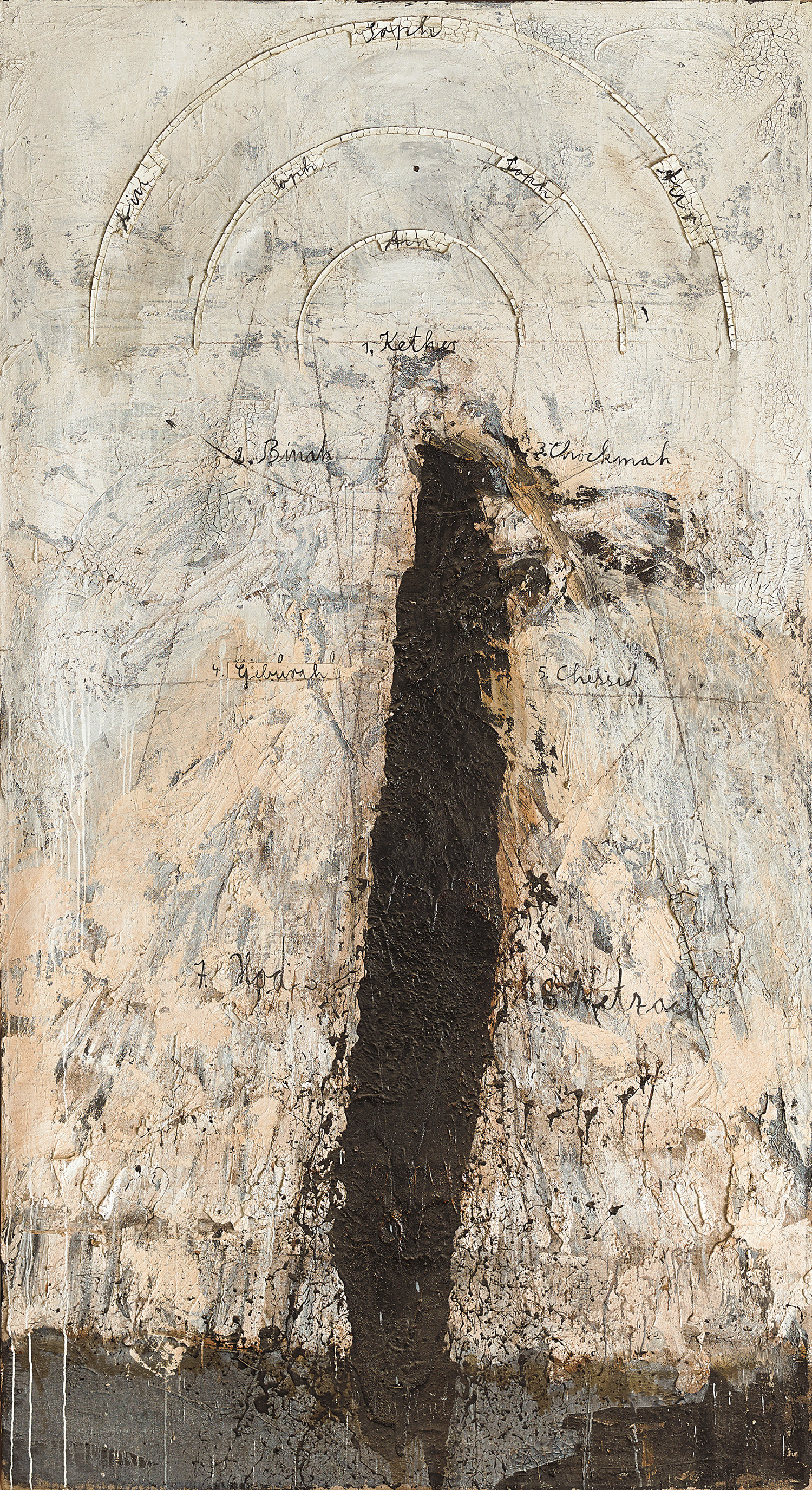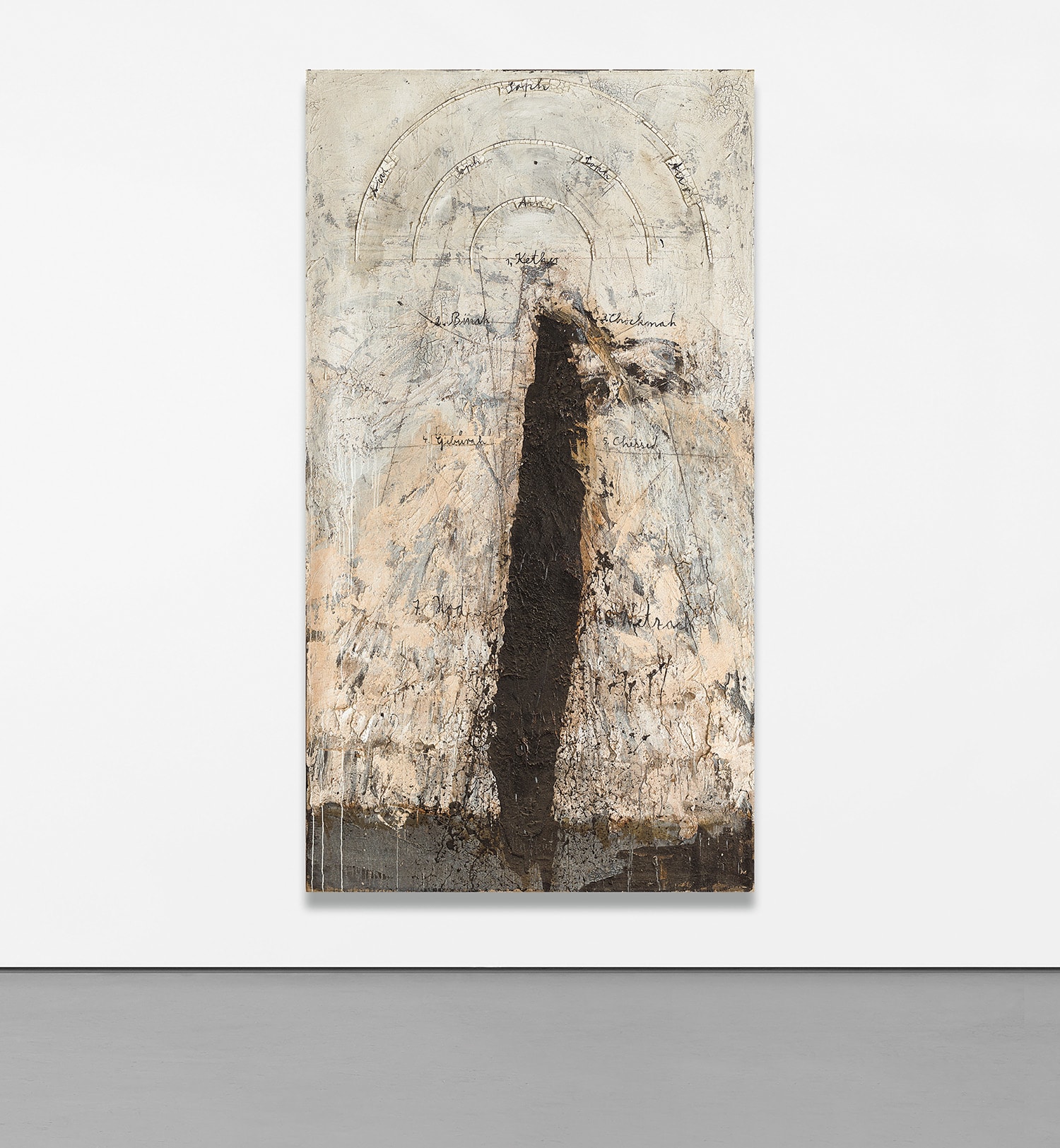



Property from an Important Private French Collection
26
Anselm Kiefer
Die Sefiroth
titled 'Die Sefiroth' on the reverse
emulsion, acrylic, charcoal and shellac on burlap
330 x 180 cm (129 7/8 x 70 7/8 in.)
Executed in 1996.
Full-Cataloguing
An expressive depiction of the symbol of life in Jewish mysticism, Die Sefiroth, 1996, encapsulates Anselm Kiefer’s faculty for realising evocative, tactile representations of occult spirituality and destruction. Portraying a single tree trunk that appears scorched black against a sand dollar-coloured background, the painting features an impastoed- and material-rich surface that reveals the violence inflicted upon it. The singed, carved, and cracked recto of Die Sefiroth is juxtaposed with a delicately-contoured silhouette of an unidentified female figure on the verso; a possible delineation of the demon Lilith, another character in Jewish folklore frequently employed in Kiefer’s visual syntax, as exemplified by Lilith, 1987-1989, Tate London. A further investigation into the raw, brutal representation of these religious subjects that Kiefer began exploring in the mid-1980s, – notably in Emanation, 1984-1986, Walker Art Center, Minneapolis – Die Sefiroth establishes a dimension that coalesces beauty with horror and gestural vigour with violence.
Die Sefiroth visualises the Tree of Life put forth by the Kabbalah, a mystical school of thought within Judaism that considers the creation of the universe and eternity of the divine. The Kabbalistic tree illustrates the sefirot, or ten emanations, the names of seven of which Kiefer scribbled as branches extending from the trunk of the tree. While some qualities are intellectual – such as chochmah (wisdom) and binah (understanding) – others are behavioural, including chesed (loving-kindness) or gevurah (mighty). Atop the tree is a separate sphere labelled Ain Soph Aur, or ‘endless light,’ referring to the metaphysical and non-physical God, reminiscent of a sun providing light for forestry. Potentially interpreted as a two-dimensional rendering of his landmark work, Breaking of the Vessels, 1990, which depicts the Kabbalistic moment when God’s sefirot were so abundant that they burst through the vessels that contained them, launching the divine into a sinful world – Die Sefiroth features similar thematic undercurrents of destruction and violence. Despite the niche Kabbalistic allusions contained within the present work, Kiefer’s oeuvre does not circle around a singular religious reference: the artist also alludes to Christian doctrines, denoting a greater investigation into the spiritual realm rather than a focused interest on a set of specific tenets.
Kiefer’s preoccupation with ethereality and the divine makes it no surprise that his work is often considered through the lens of theories of the ‘sublime’. In this way, Die Sefiroth strikes a number of similitudes with Barnett Newman’s Onement I, 1948, on both a formal and conceptual level. However, while both works aim to transcend corporeality and materiality, they achieve this elevation in contrasting styles. Newman’s thin, unembellished surface stands in stark contrast to Kiefer’s work, which pulsates with an apocalyptic and brutal sense of the sublime. According to art critic Donald Kuspit, Kiefer’s works like Die Sefiroth ‘become bankrupt, vacated, barren, the sublime turned inside out, showing the vacuum of feeling which it secretly is, the void given metaphysical status, preciousness, and dignity by reason of its apotheosis as art -- conveys a sense of insurmountable, inconsolable loss, depletion, absence and finally lifelessness’ (Donald Kuspit, ‘The Spirit of Gray’, Artnet, 2002, online). Born seven weeks before the suicide of Adolf Hitler, Kiefer’s work frequently embodies the post-war destruction that he grew up surrounded by, providing a possible interpretation of the painterly trauma and violence inflicted against the Jewish subject of Die Sefiroth.
In Die Sefiroth, Kiefer captures a form of sublime that is spiritual yet violent. Though his unique ability to associate the destruction of the past with the timelessness of truth and trauma, the artist materialises the traditional German proverb that Kuspit has associated with his work, ‘What is new is not true and what is true is not new’ (Kuspit, ‘The Spirit of Gray’, Artnet, online). It is perhaps, though, Kiefer himself who best elucidated the enigmatic spirit of Die Sefiroth by clarifying his interest in the Jewish mysticism at the heart of the picture: ‘"Kabbala[h]” means “knowledge that has been received", a secret knowledge; but I think of it as images that have been received… The [k]abbalistic tradition is not one but many, forming a sophisticated spiritual discipline. It is a paradox of logic and mystical belief. It’s part scholarship, part religion, part magic. For me, it is a spiritual journey anchored by images’ (Anselm Kiefer, quoted in ‘Heaven and Earth’, Anselm Kiefer, exh. cat., Guggenheim Museum, Bilbao, 2007, p. 339).
Die Sefiroth visualises the Tree of Life put forth by the Kabbalah, a mystical school of thought within Judaism that considers the creation of the universe and eternity of the divine. The Kabbalistic tree illustrates the sefirot, or ten emanations, the names of seven of which Kiefer scribbled as branches extending from the trunk of the tree. While some qualities are intellectual – such as chochmah (wisdom) and binah (understanding) – others are behavioural, including chesed (loving-kindness) or gevurah (mighty). Atop the tree is a separate sphere labelled Ain Soph Aur, or ‘endless light,’ referring to the metaphysical and non-physical God, reminiscent of a sun providing light for forestry. Potentially interpreted as a two-dimensional rendering of his landmark work, Breaking of the Vessels, 1990, which depicts the Kabbalistic moment when God’s sefirot were so abundant that they burst through the vessels that contained them, launching the divine into a sinful world – Die Sefiroth features similar thematic undercurrents of destruction and violence. Despite the niche Kabbalistic allusions contained within the present work, Kiefer’s oeuvre does not circle around a singular religious reference: the artist also alludes to Christian doctrines, denoting a greater investigation into the spiritual realm rather than a focused interest on a set of specific tenets.
Kiefer’s preoccupation with ethereality and the divine makes it no surprise that his work is often considered through the lens of theories of the ‘sublime’. In this way, Die Sefiroth strikes a number of similitudes with Barnett Newman’s Onement I, 1948, on both a formal and conceptual level. However, while both works aim to transcend corporeality and materiality, they achieve this elevation in contrasting styles. Newman’s thin, unembellished surface stands in stark contrast to Kiefer’s work, which pulsates with an apocalyptic and brutal sense of the sublime. According to art critic Donald Kuspit, Kiefer’s works like Die Sefiroth ‘become bankrupt, vacated, barren, the sublime turned inside out, showing the vacuum of feeling which it secretly is, the void given metaphysical status, preciousness, and dignity by reason of its apotheosis as art -- conveys a sense of insurmountable, inconsolable loss, depletion, absence and finally lifelessness’ (Donald Kuspit, ‘The Spirit of Gray’, Artnet, 2002, online). Born seven weeks before the suicide of Adolf Hitler, Kiefer’s work frequently embodies the post-war destruction that he grew up surrounded by, providing a possible interpretation of the painterly trauma and violence inflicted against the Jewish subject of Die Sefiroth.
In Die Sefiroth, Kiefer captures a form of sublime that is spiritual yet violent. Though his unique ability to associate the destruction of the past with the timelessness of truth and trauma, the artist materialises the traditional German proverb that Kuspit has associated with his work, ‘What is new is not true and what is true is not new’ (Kuspit, ‘The Spirit of Gray’, Artnet, online). It is perhaps, though, Kiefer himself who best elucidated the enigmatic spirit of Die Sefiroth by clarifying his interest in the Jewish mysticism at the heart of the picture: ‘"Kabbala[h]” means “knowledge that has been received", a secret knowledge; but I think of it as images that have been received… The [k]abbalistic tradition is not one but many, forming a sophisticated spiritual discipline. It is a paradox of logic and mystical belief. It’s part scholarship, part religion, part magic. For me, it is a spiritual journey anchored by images’ (Anselm Kiefer, quoted in ‘Heaven and Earth’, Anselm Kiefer, exh. cat., Guggenheim Museum, Bilbao, 2007, p. 339).